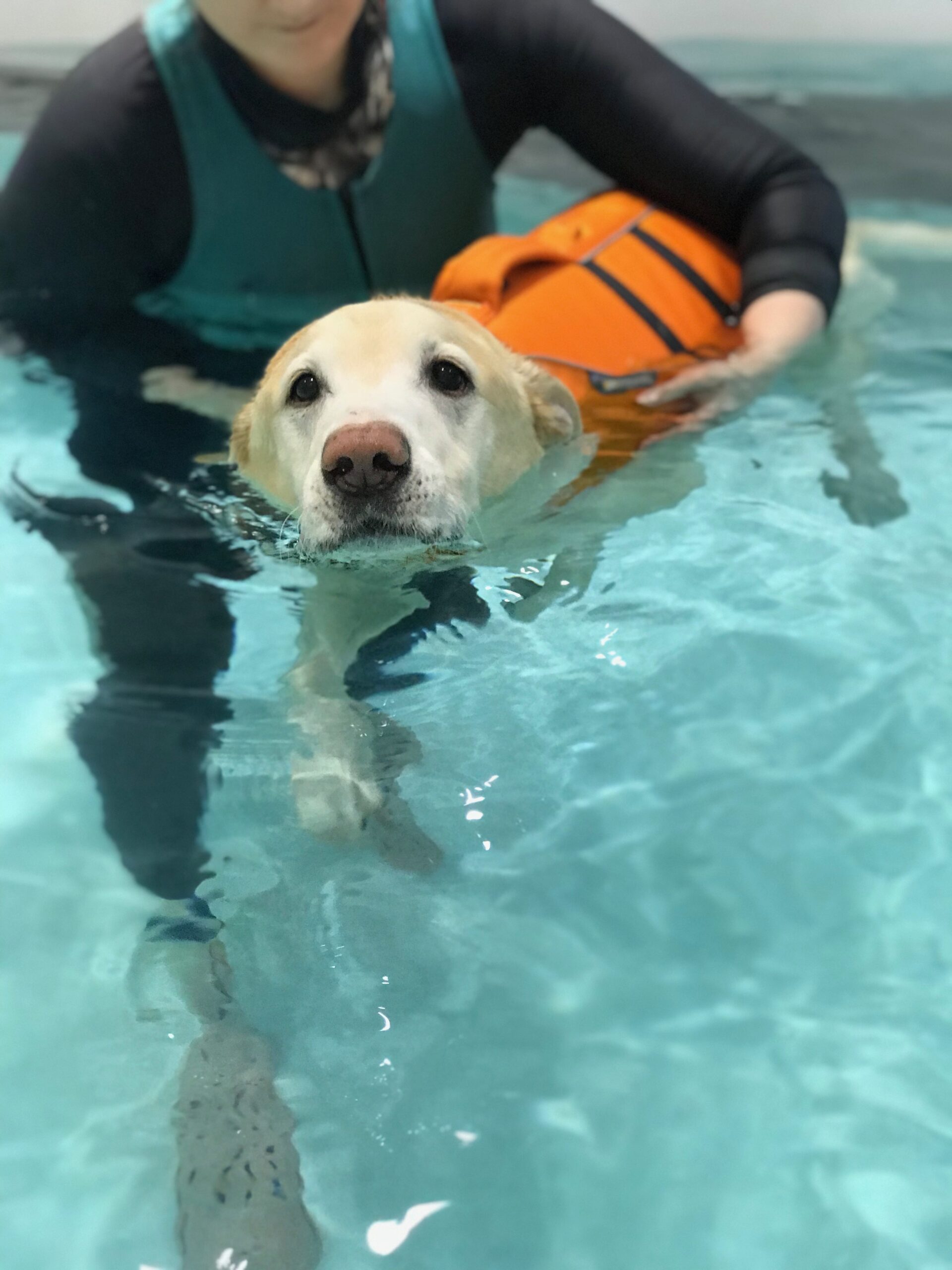Key Takeaways
- Canine hydrotherapy is a therapeutic method using water to aid recovery and rehabilitation in dogs.
- Underwater treadmills and swimming pools are key pieces of equipment in canine hydrotherapy.
- Customized recovery plans are essential for each dog’s unique post-surgery needs.
- Shelter dogs can experience significant health and behavioral improvements through hydrotherapy.
- Community support and adoption are crucial for continuing the success of hydrotherapy programs in shelters.

“Canine hydrotherapy – Wikipedia” from en.wikipedia.org and used with no modifications.
What is Canine Hydrotherapy?
Imagine a world where every step is like walking on the moon—light, effortless, and without strain. This is the reality for dogs undergoing hydrotherapy. Hydrotherapy, for our four-legged friends, is a form of physical therapy that takes place in water. Its goal? To help dogs heal and strengthen without the harsh impact of gravity. It’s a game-changer, especially for those coming out of surgery or with chronic conditions.
So, how does it work? Hydrotherapy uses the properties of water—buoyancy, resistance, and hydrostatic pressure—to create a unique environment for rehabilitation. The buoyancy of water reduces stress on joints, the resistance aids muscle strengthening, and the hydrostatic pressure decreases swelling and improves circulation. It’s a trifecta of benefits that can’t be replicated on dry land.
The Role of Hydrotherapy in Recovery and Rehabilitation
After surgery, dogs can be left weak, in pain, and with a long road to recovery. This is where hydrotherapy steps in. It’s not just about physical healing; it’s about mental well-being too. The gentle nature of water exercises means less pain and more enjoyment during recovery. This positive experience can boost a dog’s spirits and encourage a more active healing process.
Whether it’s a hip replacement or a spinal surgery, the tailored approach of hydrotherapy meets the unique needs of each canine patient. It’s not just about getting back on all fours; it’s about regaining quality of life. That’s why so many veterinarians and shelters are turning to this method—it offers a gentle yet effective path to wellness.
Equipped for Success: The Tools of Canine Hydrotherapy
Underwater Treadmills and Their Impact on Canine Recovery
The underwater treadmill is the star of the hydrotherapy show. It’s a remarkable piece of equipment that allows dogs to walk or run while being partially submerged in water. This setup enables them to move their limbs freely without the full weight of their body bearing down on them. The result? They can rebuild muscle, improve cardiovascular health, and regain mobility much faster than with traditional land-based therapies.
But it’s not just about the physical benefits. Imagine a dog who’s been cooped up in recovery, suddenly able to move in ways it hasn’t in weeks, maybe months. The mental boost is undeniable. The underwater treadmill doesn’t just help dogs get back on their paws; it lifts their spirits, giving them a sense of normalcy and fun during their rehabilitation journey.
Other Essential Rehab Equipment for Shelter Dogs
Besides the underwater treadmill, there are other heroes in the hydrotherapy toolkit. Swimming pools designed for dogs allow for non-weight-bearing exercise, which is ideal for those with severe joint issues or obesity. Then there’s the whirlpool therapy, akin to a spa treatment, which can soothe sore muscles and accelerate healing with its warm, massaging waters.
Support harnesses and life vests are also part of the ensemble, ensuring safety and confidence for dogs as they navigate the waters. Each piece of equipment plays a pivotal role in the holistic approach to canine rehabilitation. It’s about creating a suite of options that can cater to the diverse needs of shelter dogs, each with their own story and path to recovery.
Designing a Post-Surgery Recovery Blueprint
When it comes to recovery, one size does not fit all—especially for our canine companions. That’s why a tailored post-surgery recovery blueprint is vital. It’s a plan that takes into account the dog’s specific surgery, its overall health, and its unique personality. This plan isn’t just a schedule; it’s a roadmap to wellness, carefully charting the course from post-operative care to full recovery.
Assessing the Needs of Each Dog
First things first, we must assess the needs of each dog. This means understanding the nature of their surgery, the extent of their injuries, and any other health conditions they might have. It’s about getting a full picture of their health and wellness. Are they dealing with arthritis? Do they have a history of hip dysplasia? All these factors come into play when crafting a hydrotherapy plan that’s as unique as they are.
Assessment doesn’t stop at the physical. We also take a look at the dog’s mental and emotional state. A dog that’s anxious or stressed may require a different approach to one that’s full of energy and raring to go. It’s this level of detail that sets the stage for a successful recovery.
And let’s not forget the importance of monitoring progress. Regular check-ins and adjustments to the recovery plan ensure that the dog is not only improving but also enjoying the process. After all, a happy dog is a healthy dog.
Creating Individualized Hydrotherapy Plans
With a thorough assessment in hand, we can create an individualized hydrotherapy plan. This might start with gentle movements in a shallow pool and gradually build up to more challenging exercises on the underwater treadmill. The key is to introduce these activities at a pace that aligns with the dog’s healing process.
Every splash, every step, is part of a bigger journey towards recovery. And because we’re working with water, we can adjust the intensity of the exercises by simply changing the depth or the speed of the treadmill. It’s this flexibility that makes hydrotherapy so effective for a wide range of post-surgery needs.
Tales of Transformation: Shelter Dogs’ Road to Recovery
Behind every recovery is a story—a tale of resilience and the transformative power of hydrotherapy. Shelter dogs, often overlooked and with rough pasts, find a new lease on life through these water-based therapies. Their journeys are nothing short of inspirational.
A Second Chance: Meet the Dogs
Take Max, for example, a Labrador with a limp from an old injury that never properly healed. Through hydrotherapy, Max found relief from his chronic pain and regained the strength to run and play. Or consider Bella, a once-timid rescue who blossomed into a confident companion after her sessions in the pool.
These are more than just success stories; they’re reminders of the potential that lies within every shelter dog. With the right support and rehabilitation, they can overcome their physical and emotional scars to become loving and loyal pets.
From Struggle to Splash: Stories of Hope
Each splash in the water is a step towards a brighter future. Rosie, a small terrier mix, was almost paralyzed after being hit by a car. Hydrotherapy not only helped her walk again but also restored her trust in humans. And then there’s Duke, a German Shepherd who suffered from severe anxiety post-surgery. The rhythmic motion of swimming calmed his nerves and sped up his recovery.
These stories are testaments to the power of hydrotherapy—a tool that gives shelter dogs not just the strength to heal, but also the courage to trust and love again.
Extending the Ripple Effect: How You Can Help
The benefits of hydrotherapy extend far beyond the walls of the rehabilitation center. They ripple out into the community, inspiring hope and encouraging action. But these programs can’t do it alone; they thrive on community support. By reading about the success stories of those who have been helped, you can see the impact of your support.
Supporting Rehabilitation Programs in Shelters
Support can come in many forms. Donating to shelters that offer hydrotherapy programs is one way to make a direct impact. Volunteering your time is another. Shelters often need help with the day-to-day care of dogs in recovery, and your presence can make a big difference.
But support isn’t just about money and time; it’s about advocacy. By spreading the word about the benefits of hydrotherapy, you help raise awareness of this valuable resource. Share success stories, talk about the science behind it, and you’ll help ensure that more dogs get the chance they deserve.
How can I support hydrotherapy programs for shelter dogs?
Supporting hydrotherapy programs for shelter dogs is a meaningful way to contribute to the well-being of animals in need. Whether you’re a pet lover, a community member, or someone who believes in second chances, your involvement can make a significant difference.
Here are a few ways you can help:
- Financial Contributions: Donations are always welcome and can go a long way in funding the specialized equipment and trained staff required for hydrotherapy.
- Volunteering: Offering your time to assist with the daily operations of hydrotherapy sessions can be incredibly rewarding and helpful to shelters.
- Raising Awareness: Spread the word about the benefits of hydrotherapy by sharing information on social media, or talking to friends and family.
- Fundraising: Organize local events or online fundraisers to gather community support and donations for hydrotherapy programs.
- Adoption: Consider adopting a dog that has gone through hydrotherapy and needs a loving home to continue its journey to full health.
Remember, every bit of help counts and contributes to the healing and happiness of shelter dogs who have faced adversity.
How long does it typically take for a dog to recover post-surgery with hydrotherapy?
Recovery times can vary widely depending on the dog’s condition, the type of surgery, and how consistently the hydrotherapy program is followed. However, many dogs show significant improvement within 6 to 8 weeks of regular hydrotherapy sessions.
It’s important to note that while hydrotherapy can accelerate the healing process, patience is key. Some dogs may take longer to show progress, especially if they are dealing with chronic conditions or severe injuries. The goal is to create a positive, gradual path to recovery, without rushing the process and risking further injury.
Regular assessments by a veterinarian or a certified canine hydrotherapist can help to track the dog’s progress and adjust the hydrotherapy plan as needed. This ensures the dog is getting the most benefit from each session and is on the right track to regaining its strength and mobility.
Ultimately, the dedication of the shelter staff, the expertise of the hydrotherapy practitioners, and the dog’s own resilience all contribute to the recovery timeline. With the right support, dogs can not only recover but thrive post-surgery.

“Dog Hydrotherapy in Pewaukee, WI: What …” from pewaukeeveterinaryservice.com and used with no modifications.
Are there success stories of shelter dogs who’ve benefitted from hydrotherapy?
Absolutely! There are countless success stories of shelter dogs whose lives have been transformed through hydrotherapy. Take the story of a border collie named Luna, for instance. After being rescued with severe hip dysplasia, Luna was barely able to walk. Hydrotherapy played a crucial role in her recovery, allowing her to rebuild her muscle strength and regain her ability to walk—and eventually run—without pain.
Then there’s Charlie, a senior dog who suffered from arthritis and was considered unadoptable due to his limited mobility. After a few months of consistent hydrotherapy, Charlie not only became more mobile but also more playful and energetic, leading to his adoption by a family who fell in love with his newfound zest for life.
These stories are a testament to the power of hydrotherapy and the hope it can bring to shelter dogs. They prove that with the right care and rehabilitation, every dog has the potential for a happy, healthy future.





